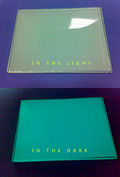
Oxide mixture, e.g., alumina and silica, applied to surface of ceramic wares to form a moisture-impervious barrierĪ hard, fine-grained, sonorous (producing sound when struck), nonporous, and usually translucent and white ceramic ware that consists essentially of kaolin (fine white clay, see: Kaopectate), quartz (silicon dioxide), and feldspar (crystalline mineral of aluminum silicates and with potassium, sodium, calcium, or barium) and fired at high temperaturesĬlayware, esp.

Style of decoration of fired enamel in raised cells, usually on a metal backing Vitreous (relating to glass) porcelain wareįine particles of hydrous aluminum silicates and other minerals Relating to manufacture of or product of nonmetallic mineral, first shaped, then hardened by heat Recognition of the hazards inherent in such applications led to regulations governing incorporation of byproduct radioactive materials, i.e., materials made radioactive through regulated activities, and of source materials, i.e., uranium and thorium, into products.īuilding or paving unit of moist clay hardened by heat Artificial teeth, jewelry-especially cloisonné jewelry, wall tiles, electrical materials, and other manufactured articles have also had radioactive materials incorporated into them for various reasons. The extension of the test to samples of older Fiesta dinnerware led to an investigation of emissions from a variety of pottery and similar items.įor over a century and a half, soils containing naturally occurring radioactive materials have been used in manufacturing glass and ceramic products, as base material, as coloring agents, and for other properties, even before the contained radioactivity was identified as such. A test of alpha emissions from samples of glazed tiles used in construction at NIST/NBS suggested that an examination of emissions from commercially available floor and wall tiles might yield useable information for alpha check sources. The need for a large-area, low-intensity alpha test source for large face area ion chambers triggered memories: first, site and area measurements with sensitive radiation monitors at the National Institute of Standards and Technology (NIST) and its predecessor agency, the National Bureau of Standards (NBS) had indicated that the general radiation level was higher in an area lined with glazed ceramic tile than in areas lined with wallboard, cinder block, or other construction materials and, second, that some dinnerware, e.g., pre-World War II Fiestaware, contained significant levels of radioactivity in materials used as coloring agents.

The results from the two assay methods are compared, and a projection of sensitivity from larger electret ion chamber devices is presented. A glass disc with known 232Th radioactivity concentration was cast for use as a calibration source. Samples of glazing paints and samples of deliberately doped glass from the World War II era were included in the test, as was a section of foam filled poster board. The glazes seemed to contribute most of the activity, although a sample of unglazed pottery greenware showed some activity.
SQUARE RADIUM GLASS MOSAIC SERIES
Almost every nuclide identification test demonstrated some radioactivity content from one or more of the naturally occurring radionuclide series of thorium or uranium. The concentrations of radioactivity ranged from near background to about four orders of magnitude higher.

The samples included tableware, construction tiles and decorative tiles, figurines, and other products with a clay based composition. Identification of radionuclides in some of the items was performed by gamma spectroscopy. A variety of commonly available household and industrial ceramic items and some specialty glass materials were assayed by alpha pulse counting and ion chamber voltage measurements for radioactivity concentrations.


 0 kommentar(er)
0 kommentar(er)
